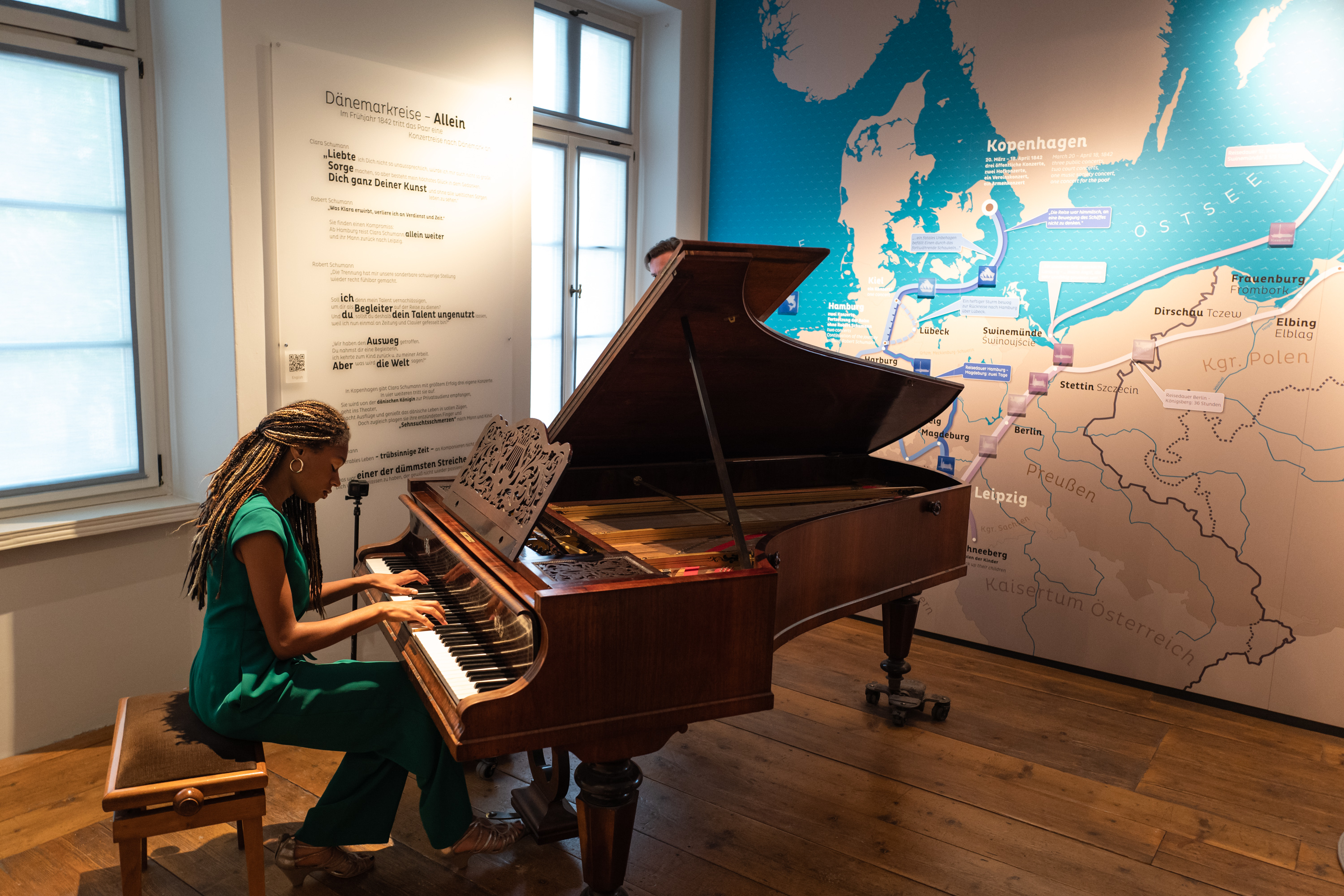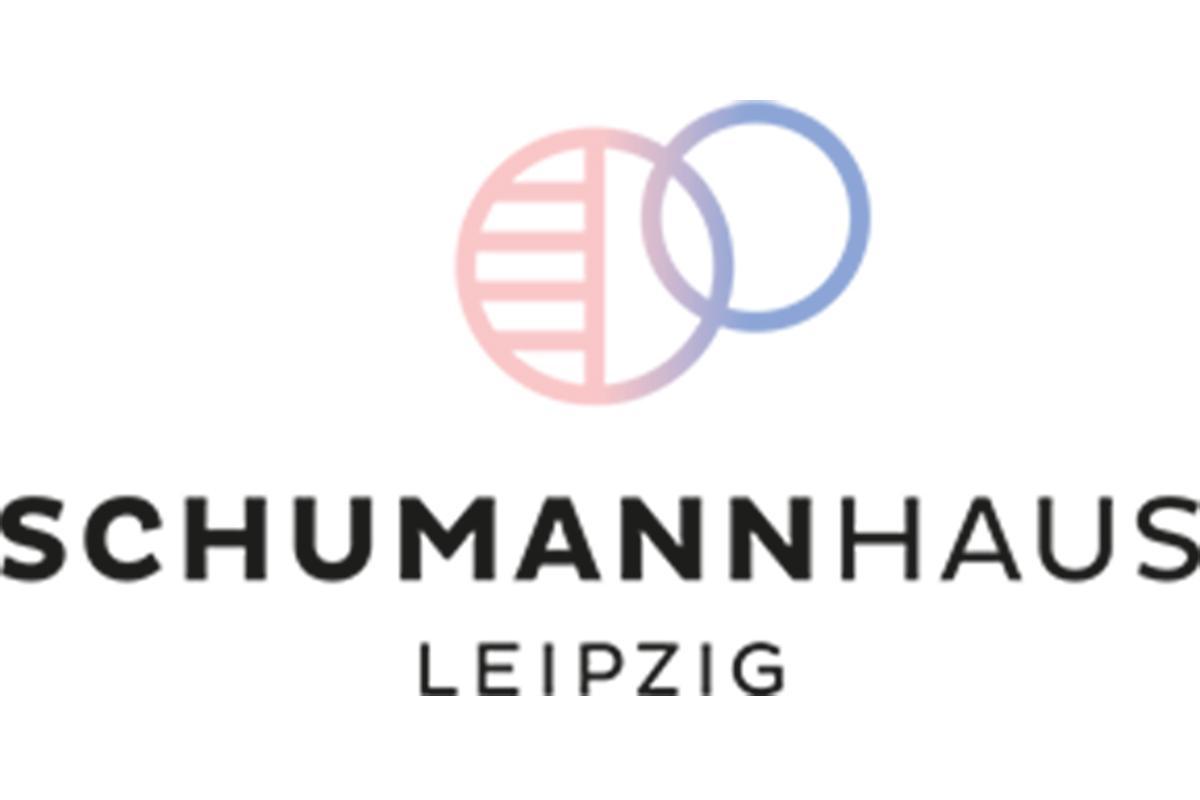New exhibition
“Experiment of an artist marriage” – the Schumanns’ years in Leipzig
The new permanent exhibition in the Schumann-Haus Leipzig – the first museum dedicated to a musician couple
“You love …? … for beauty? … for youth? … for treasures? … for love?”
Discover the Schumanns’ Leipzig years with all your senses – in the first museum dedicated to a musician couple! Explore the “experiment of an artist marriage”.
The marriage diaries, which were written in this house, and the song cycle “Liebesfrühling” (Spring of Love), which they composed together, will guide you through the museum and show how modern this couple was, even by today’s standards.
Carriage entrance and historic staircase
Enter the first apartment of the newlywed Schumanns by way of the carriage entrance
and study the biographies of Clara and Robert until their marriage. Students from the independent elementary school “Clara Schumann” will welcome and guide you through the museum,


Schumann Salon
Robert and Clara Schumann – a creative team
“Posterity shall see us as one heart and one soul …” (Robert Schumann)
Take a seat and experience the atmosphere of the salon where Clara and Robert Schumann received famous personalities and close friends. Listen to the audio features, developed especially for this room, which portray such personalities as Mariane Bargiel, the mother of Clara, Wilhelmine Schroeder-Devrient, one of the pioneering tragedienne singers of the 19th century, and the colleague in composition, Felix Mendelssohn Bartholdy.
Travel room
That which fulfills her makes him sick.
“Everyone keeps asking why I don’t travel – I will fall into total oblivion.” (Clara Schumann)
Join in and embark on the two concert tours which started in Leipzig and went to Denmark (1842) and Russia (1844). The grand tour to Russia is illustrated by an imaginative animated film from the studio “Buchstabenschubser”. The large travel trunk carries a re-enacted scene of Clara Schumann’s performance of the “Spring Song” by Felix Mendelssohn Bartholdy, which he dedicated to her, in the form of a Pepper’s Ghost, produced by Ralph Gellwitzki. Besides this, the original pincushion belonging to Clara Schumann as well as several travel accessories of the time are displayed.

Made possible by the kind support of the Mariann Steegmann Foundation
Education room
The Wieck educational ideal and today’s school
“I thank him all of my life for all of the so-called cruelties.” (Clara Schumann)
Touch Clara Schumann’s hand and make tones and even her entire compositions sound: Erwin Stache developed an extraordinary sound installation based on the plaster cast of the pianist‘s original hand.
After initially beginning piano lessons with her mother, Mariane Bargiel, her father Friedrich Wieck created an educational construct which is still reflected in part today in the artistic concept of the independent elementary school “Clara Schumann”, which is housed in the Schumann-Haus.
Marriage-experiment room
“LOVE AND ART”, “CHILDREN”, AND “MONEY”
“The wife stands even higher than the artist.” (Robert Schumann)
Come in and experience a new art form! With visual features made by Magdalene Melchers, you will transform the room into three different topics with the help of six projectors. Inspired by the words of the newlywed Schumanns, these features bring to life, both aurally and visually, the tensions between love and art, the joy and the burdens that come with children, the wealth of gifts and the struggle to make ends meet. Surrounded by associative imagery, the quotes – although comprehensively accessible to the world through letters and entries in the marriage diaries – appear in a new light, and yet remain mysterious.
In this very room, Robert Schumann once composed his Spring Symphony, Op. 38, the Dichterliebe cycle, Op. 48, as well as his piano quintet, Op. 44, which his wife first premiered in the Gewandhaus.

Listening room
CLARA AND ROBERT AFTER 1840
“Each of your thoughts comes from my very soul; indeed it is you I have to thank for all my music.” (Robert Schumann)
Listen and study Clara and Robert‘s works which they composed in Leipzig and read selected literature about the Schumanns.
We thank all of our sponsors:
- Federal Commissioner for Culture and Media
- Ministry of Science and Culture in Saxony
- City of Leipzig
- Ostdeutsche Sparkassenstiftung in cooperation with Sparkasse Leipzig
- Landesstelle für Museumswesen
- European Foundation of the Rahn Dittrich Group for Education and Culture
- Rahn Education
- Julius Blüthner pianoforte factory
- BW-Bank
Experiment of an artist marriage
Museum director: Gregor Nowak
Curator: Prof. Dr. Beatrix Borchard
Exhibition design: Homann Güner Blum studio for visual communication
Visual features and audio features in the Schumann salon: Magdalene Melchers
Sound installation “Clara‘s Hand”: Erwin Stache
Animated film about the journey to Russia: “Buchstabenschubser” studio
Performance scene of Clara Schumann as Pepper‘s Ghost: Ralph Gellwitzki
Exhibits
Square piano belonging to Friedrich Wieck, Leipzig
Signed: “Pianoforte Magazin von Friedrich Wieck in Leipzig” ca. 1825
Concert grand piano, label of Wilhelm Wieck, Dresden
Signed: “W. Wieck – Dresden” pearl inlay next to the signet, c. 1860, mahogany veneer
Travel dress like 1839 for Clara Wieck
Made by Monika Schröter for her 2009 final project for a diploma in costume design at the Dresden University of Fine Arts
Ernst Rietschel
Robert and Clara Schumann
Relief, plaster, 1846
Original pincushion belonging to Clara Schumann with her initials
Transcribed autograph (two bars from Robert Schumann’s Op. 68, no. 10 “Fröhlicher Landmann, von der Arbeit zurückkehrend”. Sheet from a notebook written and signed in her own hand. London, June 1857. Autograph of Clara Schumann)
as well as travel utensils from the time, or replicas
